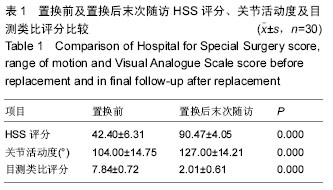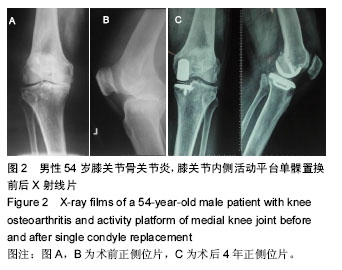| [1] Goodfellow JW, O’Connor J. Clinical results of the Oxford knee surface arthroplasty of the tibiofemoral joint with a meniscal bearing prosthesis. Clin Orthop Relat Res. 1986;205:21-42.
[2] White SH, Ludkowski PF, Goodfellow JW. Anterome- dial osteoarthritis of the knee. J Bone Joint Surg Br. 1991;73(4):582-586.
[3] Kozinn SC, Marx C, Scott RD. Unicompartmenta lknee arthroplasty a 4.5-6-year follow-up study with a metal-backed tibial component. J Arthroplasty. 1989;4: S1-10.
[4] Pandit H,Jenkins C,Gill HS,etal.Unnecessary contraindications for mobile-bearing unicompartmental knee replacement. J Bone Joint Surg Br. 2011; 93(5): 622-628.
[5] Lindstrand A, Stenstrom A. Polyethylene wear of the PCA unicompartmental knee prospective 5 (4–8)year study of 120 arthrosis knees. Acta Orthop Scand. 1992; 63(3):260-262.
[6] Price AJ, Short A, Kellett C, et al. Ten-year in vivo wear measurement of a fully congruent mobile bearing unicompartmental knee arthroplasty. J Bone Joint Surg Br. 2005;87(11):1493-1497.
[7] 鲁宁,杨阳,Alejandro Gonzalez Della Valle,等.多重血栓预防方案在髋关节置换中的应用[J].实用医学杂志, 2013, 29(14):104-106.
[8] McKeever DC. Tibial plateau prosthesis. Clin Orthop. 1960;18:86-95.
[9] MacIntosh DL, Hunter GA. The use of the hemiarthroplasty prosthesis for advanced osteoarthritis and rheumatoid arthritis of the knee. J Bone Joint Surg Br. 1972;54:244-255.
[10] MacIntosh DL. Arthroplasty of the knee in rheumatoid arthritis using the hemiarthroplasty prosthesis. In: Stuttgart GC, editor. Synovectomy and Arthroplasty in rheumatoid arthritis; second international symposium. Stuttgart, Germany 7 Theime, 1967:79.
[11] Friedman MJ. UniSpacer. Arthroscopy. 2003;19(10): 120-121.
[12] Skolnick M, Peterson LF, Combs JJ. Polycentric knee arthroplasty. A two-year follow-up study. J Bone Joint Surg.1975;57A:1033.
[13] Skolnick M, Coventry M, Ilstrup D. Geometric total knee arthroplasty. A two-year follow-up study. J Bone Joint Surg Am.1976;58A:749-753
[14] Insall J, Aglietti P. A five- to seven-year follow-up of unicondylar arthroplasty. J Bone Joint Surg. 1980;62A: 1329-1337.
[15] Kozinn SC, Scott R. Unicondylar knee arthroplasty. J Bone Joint Surg Am. 1989;71:145-150.
[16] Berger RA, Meneghini RM, Jacobs JJ, et al. Results of unicompartmental knee arthroplasty at a minimum of 10 years follow-up. J Bone Joint Surg Am. 2005;87: 999.
[17] Foran JR, Brown NM, Della Valle CJ, et al, .Long-term survivorship and failure modes of unicompartmental knee arthroplasty. Clin Orthop Relat Res. 2013;471(1): 102-108.
[18] Ritter MA, Faris PM, Thong AE, et al. Intra-operative findings in varusosteoarthritis of the knee: An analysisof preoperative alignment in potentialcandidates for unicompartmental arthroplasty.J Bone Joint Surg Br. 2004;86:43-47.
[19] White SH, Ludkowski PF, Goodfellow JW. Anteromedial osteoarthritis of the knee. J Bone Joint Surg Br. 1991;73(4):582-586.
[20] Goodfellow J, O’Connor J, Dodd C, et al. Unicompartmental arthroplasty with the Oxford knee. Oxford (United Kingdom): Oxford University Press, 2006: 1-67.
[21] Berend KR, Lombardi AV Jr, Adams JB. Obesity, young age, patellofemoral disease,and anterior knee pain: identifying the unicondylar arthroplasty patient inthe United States. Orthopedics. 2007;30:19-23.
[22] Pandit H, Jenkins C, Gill HS, et al. Unnecessary contraindications for mobile bearing unicompartmental knee replacement. J Bone Joint Surg Br. 2011;93(5): 622-628.
[23] Wainwright C, Theis JC, Garneti N, et al. Age at hip or knee joint replacement surgery predicts likelihood of revision surgery. J Bone Joint Surg Br. 2011;93(10): 1411-1415.
[24] Kandil A, Werner BC, Gwathmey WF,et al. Obesity, morbid obesity and their related medical comorbidities are associated with increased complications and revision rates after unicompartmental knee arthroplasty. J Arthroplasty. 2015;30(3):456-460.
[25] Murray DW, Goodfellow JW, O’Connor JJ. The Oxford medial unicompartmental arthroplasty: a ten-year survival study. J Bone Joint Surg Br. 1998;80(6): 983-989.
[26] Svard UC, Price AJ. Oxford medial unicompartmental knee arthroplasty: a survival analysis of an independent series. J Bone Joint Surg Br. 2001;83(2): 191-194.
[27] Price AJ, Svard U. A second decade lifetable survival analysis of the Oxford unicompartmental knee arthroplasty. Clin Orthop Relat Res. 2011;469(1): 174-179.
[28] Gulati A,Chau R, Simpson DJ,et al.Influence of component alignment on outcome for unicompartmental replacement. Knee. 2009;16: 196-199.
[29] Morris MJ, Molli RG, Berend KR, et al. Mortality and perioperative complications after unicompartmental knee arthroplasty. Knee. 2012;20:218-220.
[30] 张曦,高俊,吕正祥.Oxford单髁置换治疗膝内侧间室骨性关节炎[J]. 临床骨科杂志,2015, 18(1):45-47
[31] 马广文,尹宗生,黄斐,等.单髁置换术治疗膝关节内侧间室骨关节炎初期疗效[J].中国修复重建外科杂志,2014, 28(10):1208-1211. |
.jpg)



.jpg)
.jpg)